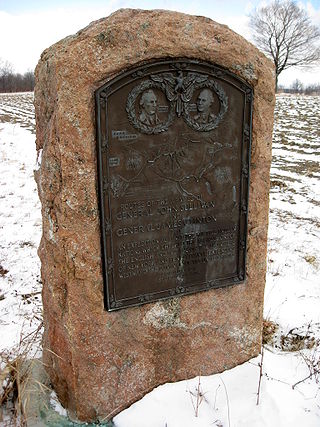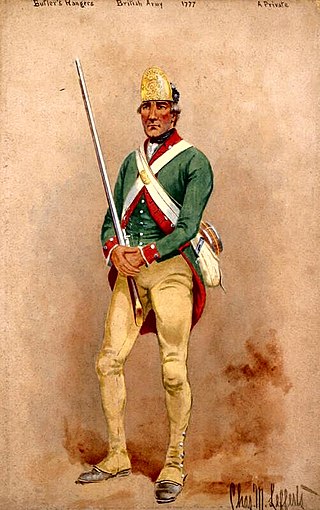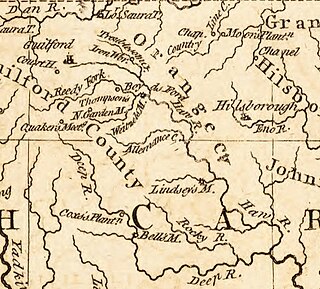
The 1779 Sullivan Expedition was a United States military campaign during the American Revolutionary War, lasting from June to October 1779, against the four British allied nations of the Iroquois. The campaign was ordered by George Washington in response to the 1778 Iroquois and British attacks on Wyoming, German Flatts, and Cherry Valley. The campaign had the aim of "taking the war home to the enemy to break their morale". The Continental Army carried out a scorched-earth campaign in the territory of the Iroquois Confederacy in what is now western and central New York.

Butler's Rangers (1777–1784) was a Loyalist provincial military unit of the American Revolutionary War, raised by American loyalist John Butler. Most members of the regiment were Loyalists from upstate New York and northeastern Pennsylvania. Their winter quarters were constructed on the west bank of the Niagara River, in what is now Niagara-on-the-Lake, Ontario. The Rangers fought principally in New York and Pennsylvania, but ranged as far west as Ohio and Michigan, and as far south as Virginia and Kentucky.
Captain Walter Butler was an American-born Loyalist military officer during the American Revolutionary War. He was born near Johnstown, New York, the son of John Butler, an Indian agent who worked for Sir William Johnson. Walter Butler studied law, and became a lawyer in Albany, New York prior to the American Revolution. He was killed in battle in 1781.

The King's Royal Regiment of New York, also known as Johnson's Royal Regiment of New York, King's Royal Regiment, King's Royal Yorkers, and Royal Greens, were one of the first Loyalist regiments, raised on June 19, 1776, in British Canada, during the American Revolutionary War.

The 1st Rhode Island Regiment was a regiment in the Continental Army raised in Rhode Island during the American Revolutionary War (1775–83). It was one of the few units in the Continental Army to serve through the entire war, from the siege of Boston to the disbanding of the Continental Army on November 3, 1783.

The 2nd Rhode Island Regiment was authorized on 6 May 1775 under Colonel Daniel Hitchcock in the Rhode Island Army of Observation and was organized on 8 May 1775 as eight companies of volunteers from Providence County of the colony of Rhode Island. As part of a brigade organized under Nathanael Greene, the unit participated in the Siege of Boston during the remainder of 1775. Some elements accompanied Benedict Arnold's expedition to Quebec late in the year. The unit was renamed the 11th Continental Regiment on the first day of 1776.
The 2nd New Jersey Regiment was raised, on 9 October 1775, at Trenton, New Jersey, for service with the Continental Army under the command of Colonel William Maxwell. The regiment would see action at the Battle of Trois-Rivières, Battle of Valcour Island, Battle of Brandywine, Battle of Germantown, Battle of Crooked Billet, Battle of Monmouth, Sullivan Expedition, Battle of Springfield and the Battle of Yorktown. The regiment was furloughed, on 6 June 1783, at Newburgh, New York, and disbanded 3 November 1783.

The 6th Maryland Regiment, active from 27 March 1776—January 1, 1783, is most notable for its involvement during the American Revolutionary war of the same years. An infantry type regiment consisting of 728 soldiers, the 6th Maryland was composed of eight companies of volunteers from Prince Georges, Queen Anne's, Fredrick, Cecil, Harford, and Ann Arundel counties in the colony of Maryland

David Fanning was a Loyalist leader in the American Revolutionary War in North and South Carolina. Fanning participated in approximately 36 minor engagements and skirmishes, and in 1781, captured the Governor of North Carolina, Thomas Burke, from the temporary capital at Hillsborough. Additionally, Fanning was captured by Patriot forces 14 times throughout the war, each time escaping or receiving a pardon. After the British defeat in the war, Fanning fled to Canada, where he was elected to the Legislative Assembly of New Brunswick from 1791 to 1801 representing Kings County. After being convicted of rape in 1801, Fanning was expelled from New Brunswick, and settled in Nova Scotia, where he lived the remainder of his life.

The northern theater of the American Revolutionary War after Saratoga consisted of a series of battles between American revolutionaries and British forces, from 1778 to 1782 during the American Revolutionary War. It is characterized by two primary areas of activity. The first set of activities was based around the British base of operations in New York City, where each side made probes and counterprobes against the other's positions that sometimes resulted in notable actions. The second was essentially a frontier war in Upstate New York and rural northern Pennsylvania that was largely fought by state militia companies and some Indian allies on the American side, and Loyalist companies supported by Indians, British Indian agents, and occasionally British regulars. The notable exception to significant Continental Army participation on the frontier was the 1779 Sullivan Expedition, in which General John Sullivan led an army expedition that drove the Iroquois out of New York. The warfare amongst the splinters of the Iroquois Six Nations were particularly brutal, turning much of the Indian population into refugees.

The Battle of Lindley's Mill took place in Orange County, North Carolina, on September 13, 1781, during the American Revolutionary War. The battle took its name from a mill that sat at the site of the battle on Cane Creek, which sat along a road connecting what was then the temporary state capital, Hillsborough, with Wilmington, North Carolina.
The Battle of Klock's Field was an engagement during the American Revolutionary War in the Mohawk Valley region of New York between British, Loyalist and Iroquois forces led by Lieutenant Colonel Sir John Johnson, and New York Levies and militia led by Brigadier General Robert Van Rensselaer. The battle occurred on the north side of the Mohawk River in what is now St. Johnsville in Montgomery County. The result was inconclusive with neither side able to claim a clear victory.
The creation of the Tryon County, New York militia was authorized on March 8, 1772, when the Province of New York passed a bill for the establishment of organized militia in each county in the colony. By 1776, the Tryon County militia had in effect become an army of rebellion under the control of the Tryon County Committee of Safety. The Tryon County militia would go on to fight at the important battles of Oriskany and Johnstown during the war.
The Volunteers of Ireland, also known as the 2nd American Regiment and the 105th Regiment of Foot, was a British Provincial military unit, raised for Loyalist service, during the American Revolutionary War, which was later added to the British regular army. The Volunteers of Ireland should not be confused with the contemporaneous Irish Volunteers an autonomous militia that supported the Irish Patriot Party, in the 1770s and 1780s.

The Raid on Unadilla and Onaquaga was a series of military operations by Continental Army forces and New York militia against the Iroquois towns of Unadilla and Onaquaga in what is now upstate New York. In early October 1778, more than 250 men under the command of Lieutenant Colonel William Butler of the 4th Pennsylvania Regiment descended on the two towns and destroyed them, razing most of the buildings and taking or destroying provisions, including the people's winter stores.
John Butler was a military officer in the Hillsborough District Brigade of the North Carolina militia during the American Revolutionary War from 1775 to 1784, and served as its commanding general between 1779 and the end of the conflict. He was a member of the North Carolina House of Commons for several terms simultaneously with his military service. Butler commanded soldiers in several major engagements throughout North and South Carolina, but is perhaps best remembered for his role in the Patriot defeat at the Battle of Lindley's Mill. Butler died shortly after the end of the war, and his career as a military commander has received mixed reviews by historians.
Thomas Eaton was a military officer in the North Carolina militia during the War of the Regulation in 1771 and American Revolutionary War from 1775 to 1784. He was a member of the North Carolina Provincial Congress and North Carolina House of Commons for several terms simultaneously with his military service. Eaton was a member of the North Carolina Council of State under Governor Richard Caswell. Eaton commanded soldiers in the battles of Brier Creek and Guilford Courthouse. At the time of the 1790 census, Eaton was one of the largest slaveholders in North Carolina.